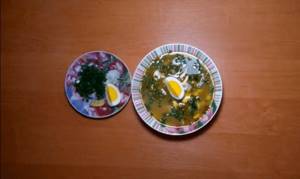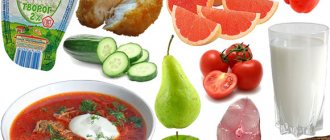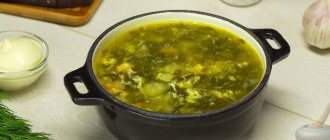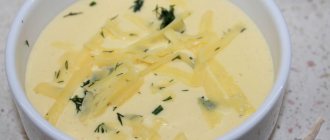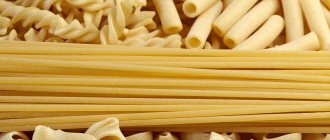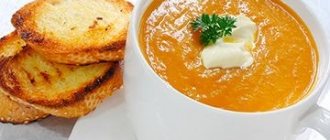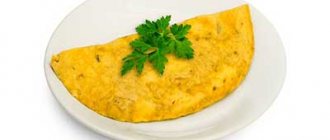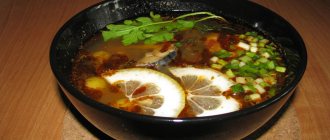We are all accustomed to the classic red soup recipe. However, few people make green borscht with sorrel, although it turns out very tasty.
Recently I talked about borscht with beans. Now it's time to share another dish with you in this article.
This dish has many names: cabbage soup, borscht and others. This does not change its taste. Next, I will tell you how to prepare classic, meat and chicken soup. You will learn how to make a dish in a slow cooker, as well as with nettles.
Each recipe comes with colorful photographs and a detailed description of the cooking steps. But I'll start with the calorie content of the soup.
Calorie content of borscht with beef
Most often, a hearty and nutritious soup for the whole family is prepared with beef (on the bone or with fillet). What is the energy value of classic borscht? Calculating the calorie content of the first course per 100 grams, we get 50.1 kcal. The BJU of such a soup, which is prepared by cooking without draining, is:
- proteins - 3.9 g;
- fats - 2.5 g;
- carbohydrates - 3.1 g.
Considering that the traditional portion served in a deep plate is 250 grams, 1 plate contains 125.3 kcal. At the same time, BZHU is presented in 9.8/6.3/7.8 g, respectively.
If you use fresh cabbage instead of sauerkraut to prepare borscht, the energy value and other indicators will be higher.
What is the calorie content of a plate of borscht?
We figured out the calorie content of borscht per 100 grams of ready-made dish. But this is not entirely convenient for calculations. Therefore, now we will talk about the calorie content of 1 plate of borscht.
It’s worth noting right away that the sizes of the plates vary. On supermarket shelves you can find both giant plates that hold 500-600 milliliters of liquid, and small plates with a volume of only 200 milliliters. Therefore, to know exactly the capacity of your plate, fill it with water, and then pour the water into a measuring glass (you can do it in several steps), then you will know exactly how much liquid your dish can hold and what the calorie content of a plate of borscht is.
For example, let's take a standard portion (300 grams). Accordingly, the calorie content of a plate of borscht (classic) will range from 90 to 550 kcal. But if you decide to add sour cream or toasted crackers to the borscht, the calorie content will increase in accordance with the calorie content of the additives. Therefore, we strongly recommend that people who are on a diet or have heart problems do not overuse rich borscht with various high-calorie additives.
Delicious recipe! How to squeeze juice out of onions
The calorie content of a standard plate of green borscht ranges from 110 to 515 kcal. Follow the same rule here. Do not overeat fatty foods. It will not benefit your body, but will only complicate the work of the heart, contribute to the formation of blood clots and blockage of blood vessels.

Calorie content of borscht with chicken
Less often (but this interpretation also occurs) borscht is cooked with turkey or chicken. It contains a standard set of ingredients. The only exception is meat - usually chicken breast. This option without frying gives only 28.4 kcal per 100 grams of the finished dish. The BJU in borscht with chicken broth will be as follows:
- proteins - 1.9 g;
- fats - 0.4 g;
- carbohydrates - 4.4 g.
The energy and nutritional value of the soup will increase if you use chicken with skin. But refusing to add potatoes will reduce these indicators.

How many calories are in different types of borscht?
Let's start by determining the calorie content of classic borscht. Red borscht, prepared without meat, has a calorie content of 30 kcal per 100 grams. Borscht in chicken broth without skin - 35 kcal per 100 grams, with skin - 52 kcal per 100 grams. If the dish is cooked in beef or pork broth, its calorie content increases at least 2 times. The calorie content of borscht with beef is 86 kcal per 100 grams, with lean pork - 105 kcal, with fatty pork - as much as 160 kcal per 100 grams. But the fattest is borscht with lard, its calorie content is 189 kcal per 100 grams.
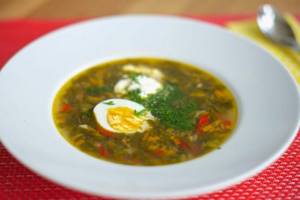
Let's move on to the calorie content of green borscht. Lean green borscht has a calorie content of 37 kcal, but beef borscht will cost 95 kcal. The calorie content of green borscht with pork will be 166 kcal per 100 grams.
Of course, it is worth considering that the calorie content of borscht depends on the amount of meat, vegetables and other additives in it.
Calorie content of borscht with sour cream
Traditionally serving borscht at the table involves adding sour cream. But keep in mind: on average 1 tbsp. A spoonful of sauce adds another 25 units to the standard calorie content of the dish. It turns out that if the energy value of homemade soup prepared with beef broth is 50 units, then a serving of borscht with a spoonful of sour cream comes out to 75 kcal.
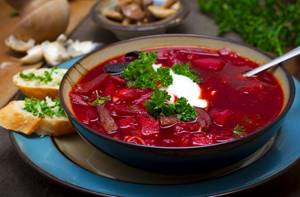
Photo source: shutterstock.com
What is the BJU of such a first course? Of course, it can be prepared in different ways, and this ratio depends on the selected components. But if you cook borscht according to the classic recipe and add 1 tbsp per 100 g. l. sour cream, then the output can be 5.1 g of carbohydrates, 3.6 g of fat and 4.2 g of protein.
If you use mayonnaise rather than sour cream as a dressing for borscht, then the calorie content of even the lean version will be higher.
Calorie content of all green borschts in a row:

Didn't find the product or dish you were looking for?
Let us know in a comment and we will add it:
Borscht is the first dish eaten in Eastern Europe. It has Ukrainian roots and stands out for its bright color and rich taste. Classic borscht is prepared with meat broth; the required ingredients are beets, potatoes, cabbage and tomatoes.
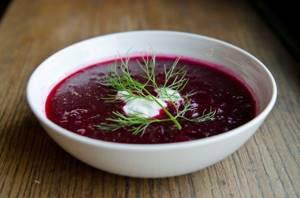
Daily intake of borscht
How much borscht can you eat every day? The exact amount depends on the person's needs and lifestyle. This dish contains most of the valuable vitamins and micronutrients. Therefore, if you wish, you can only eat borscht.
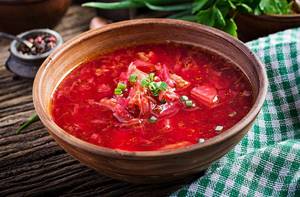
Photo source: shutterstock.com
But here you need to take into account that people employed in heavy production require 4000-5000 kcal per day. If you lead a sedentary lifestyle, then the number of required kilocalories drops to 2500.
Knowing the energy value of a particular type of dish, it will not be difficult to independently calculate the daily intake. For example, if the average calorie content of beef borscht is about 100 kcal per 100 grams, then you can eat a lot of it every day.
Recipe Green borscht. Calorie, chemical composition and nutritional value.
Nutritional value and chemical composition of “Green borscht”.
The table shows the nutritional content (calories, proteins, fats, carbohydrates, vitamins and minerals) per 100 grams of edible portion.
| Nutrient | Quantity | Norm** | % of the norm in 100 g | % of the norm in 100 kcal | 100% normal |
| Calorie content | 47.6 kcal | 1684 kcal | 2.8% | 5.9% | 3538 g |
| Squirrels | 2.9 g | 76 g | 3.8% | 8% | 2621 g |
| Fats | 1.5 g | 56 g | 2.7% | 5.7% | 3733 g |
| Carbohydrates | 5.4 g | 219 g | 2.5% | 5.3% | 4056 g |
| Organic acids | 0.1 g | ~ | |||
| Alimentary fiber | 0.5 g | 20 g | 2.5% | 5.3% | 4000 g |
| Water | 34.5 g | 2273 g | 1.5% | 3.2% | 6588 g |
| Ash | 0.293 g | ~ | |||
| Vitamins | |||||
| Vitamin A, RE | 64.7 mcg | 900 mcg | 7.2% | 15.1% | 1391 g |
| Retinol | 0.006 mg | ~ | |||
| beta carotene | 0.361 mg | 5 mg | 7.2% | 15.1% | 1385 g |
| Vitamin B1, thiamine | 0.033 mg | 1.5 mg | 2.2% | 4.6% | 4545 g |
| Vitamin B2, riboflavin | 0.031 mg | 1.8 mg | 1.7% | 3.6% | 5806 g |
| Vitamin B4, choline | 7.45 mg | 500 mg | 1.5% | 3.2% | 6711 g |
| Vitamin B5, pantothenic | 0.092 mg | 5 mg | 1.8% | 3.8% | 5435 g |
| Vitamin B6, pyridoxine | 0.07 mg | 2 mg | 3.5% | 7.4% | 2857 g |
| Vitamin B9, folates | 2.863 mcg | 400 mcg | 0.7% | 1.5% | 13971 g |
| Vitamin B12, cobalamin | 0.011 mcg | 3 mcg | 0.4% | 0.8% | 27273 g |
| Vitamin C, ascorbic acid | 4.16 mg | 90 mg | 4.6% | 9.7% | 2163 g |
| Vitamin D, calciferol | 0.037 mcg | 10 mcg | 0.4% | 0.8% | 27027 g |
| Vitamin E, alpha tocopherol, TE | 0.203 mg | 15 mg | 1.4% | 2.9% | 7389 g |
| Vitamin H, biotin | 0.521 mcg | 50 mcg | 1% | 2.1% | 9597 g |
| Vitamin K, phylloquinone | 8.2 mcg | 120 mcg | 6.8% | 14.3% | 1463 g |
| Vitamin RR, NE | 0.7326 mg | 20 mg | 3.7% | 7.8% | 2730 g |
| Niacin | 0.413 mg | ~ | |||
| Macronutrients | |||||
| Potassium, K | 166.26 mg | 2500 mg | 6.7% | 14.1% | 1504 g |
| Calcium, Ca | 9.11 mg | 1000 mg | 0.9% | 1.9% | 10977 g |
| Silicon, Si | 5.571 mg | 30 mg | 18.6% | 39.1% | 539 g |
| Magnesium, Mg | 11.18 mg | 400 mg | 2.8% | 5.9% | 3578 g |
| Sodium, Na | 12.02 mg | 1300 mg | 0.9% | 1.9% | 10815 g |
| Sera, S | 12.57 mg | 1000 mg | 1.3% | 2.7% | 7955 g |
| Phosphorus, P | 27.3 mg | 800 mg | 3.4% | 7.1% | 2930 g |
| Chlorine, Cl | 18.31 mg | 2300 mg | 0.8% | 1.7% | 12561 g |
| Microelements | |||||
| Aluminium, Al | 102 mcg | ~ | |||
| Bor, B | 19 mcg | ~ | |||
| Vanadium, V | 16.98 mcg | ~ | |||
| Iron, Fe | 0.45 mg | 18 mg | 2.5% | 5.3% | 4000 g |
| Yod, I | 1.4 mcg | 150 mcg | 0.9% | 1.9% | 10714 g |
| Cobalt, Co | 1.225 mcg | 10 mcg | 12.3% | 25.8% | 816 g |
| Lithium, Li | 8.146 mcg | ~ | |||
| Manganese, Mn | 0.0351 mg | 2 mg | 1.8% | 3.8% | 5698 g |
| Copper, Cu | 47.4 mcg | 1000 mcg | 4.7% | 9.9% | 2110 g |
| Molybdenum, Mo | 1.428 mcg | 70 mcg | 2% | 4.2% | 4902 g |
| Nickel, Ni | 1.427 mcg | ~ | |||
| Tin, Sn | 0.09 mcg | ~ | |||
| Rubidium, Rb | 77 mcg | ~ | |||
| Selenium, Se | 0.648 mcg | 55 mcg | 1.2% | 2.5% | 8488 g |
| Strontium, Sr | 1.56 mcg | ~ | |||
| Fluorine, F | 8.24 mcg | 4000 mcg | 0.2% | 0.4% | 48544 g |
| Chromium, Cr | 1.23 mcg | 50 mcg | 2.5% | 5.3% | 4065 g |
| Zinc, Zn | 0.1205 mg | 12 mg | 1% | 2.1% | 9959 g |
| Zirconium, Zr | 0.3 mcg | ~ | |||
| Digestible carbohydrates | |||||
| Starch and dextrins | 2.412 g | ~ | |||
| Mono- and disaccharides (sugars) | 1.1 g | max 100 g | |||
| Glucose (dextrose) | 0.179 g | ~ | |||
| Sucrose | 0.344 g | ~ | |||
| Fructose | 0.068 g | ~ | |||
| Essential amino acids | 0.134 g | ~ | |||
| Arginine* | 0.039 g | ~ | |||
| Valin | 0.039 g | ~ | |||
| Histidine* | 0.014 g | ~ | |||
| Isoleucine | 0.03 g | ~ | |||
| Leucine | 0.047 g | ~ | |||
| Lysine | 0.045 g | ~ | |||
| Methionine | 0.013 g | ~ | |||
| Methionine + Cysteine | 0.023 g | ~ | |||
| Threonine | 0.032 g | ~ | |||
| Tryptophan | 0.01 g | ~ | |||
| Phenylalanine | 0.033 g | ~ | |||
| Phenylalanine+Tyrosine | 0.06 g | ~ | |||
| Nonessential amino acids | 0.225 g | ~ | |||
| Alanin | 0.037 g | ~ | |||
| Aspartic acid | 0.084 g | ~ | |||
| Glycine | 0.029 g | ~ | |||
| Glutamic acid | 0.118 g | ~ | |||
| Proline | 0.026 g | ~ | |||
| Serin | 0.042 g | ~ | |||
| Tyrosine | 0.028 g | ~ | |||
| Cysteine | 0.011 g | ~ | |||
| Sterols (sterols) | |||||
| Cholesterol | 11.63 mg | max 300 mg | |||
| Saturated fatty acids | |||||
| Saturated fatty acids | 0.2 g | max 18.7 g | |||
| 14:0 Miristinovaya | 0.001 g | ~ | |||
| 16:0 Palmitinaya | 0.046 g | ~ | |||
| 17:0 Margarine | 0.001 g | ~ | |||
| 18:0 Stearic | 0.017 g | ~ | |||
| 20:0 Arakhinovaya | 0.001 g | ~ | |||
| Monounsaturated fatty acids | 0.131 g | min 16.8 g | 0.8% | 1.7% | |
| 16:1 Palmitoleic | 0.007 g | ~ | |||
| 18:1 Oleic (omega-9) | 0.095 g | ~ | |||
| 20:1 Gadoleic (omega-9) | 0.001 g | ~ | |||
| Polyunsaturated fatty acids | 0.038 g | from 11.2 to 20.6 g | 0.3% | 0.6% | |
| 18:2 Linolevaya | 0.032 g | ~ | |||
| 18:3 Linolenic | 0.015 g | ~ | |||
| 20:4 Arachidonic | 0.002 g | ~ |
The energy value of Green borscht is 47.6 kcal.
Primary Source: Created in the application by the user. Read more.
** This table shows the average levels of vitamins and minerals for an adult. If you want to know the norms taking into account your gender, age and other factors, then use the “My Healthy Diet” application.
The benefits and harms of borscht
What are the beneficial properties of borscht? If we are talking about soup made with meat broth, traditional in Russian and Ukrainian culture, then we can safely talk about its positive properties for the health of adult men and women, as well as children.
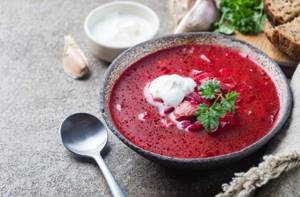
Photo source: shutterstock.com
So what is this soup good for our body? The secret of borscht is simple - due to a balanced combination of proteins, enzymes, fats, vitamins, minerals and carbohydrates, the dish is optimal for nutrition. Red borscht (like its green version with sorrel and egg) allows you to:
- normalize the functioning of the gastrointestinal tract;
- improve the functioning of the intestines and stomach;
- provide the body with fiber due to the high content of vegetables;
- strengthen human immunity.
In addition, after heat treatment, vegetables turn into a useful and delicate sorbent, which gently but effectively removes toxins, nitrates, heavy metals, waste and radionuclides from the human body.
Borscht also has a beneficial effect on metabolic processes and promotes weight loss. The substances contained in its composition are involved in the mechanism of hematopoiesis and the prevention of diabetes mellitus.

Photo source: shutterstock.com
But in some cases, borscht may not be harmless at all. When does it harm the body? The danger occurs with certain contraindications:
- pancreatitis;
- cholecystitis;
- kidney diseases, especially during exacerbation.
In addition, carrots and cabbage, which are necessarily included in the recipe, are leaders in the degree of nitrate absorption. Accordingly, they give them to us. To avoid harm from borscht, it is recommended to use only high-quality vegetables, preferably from your own garden.

Sorrel green borscht in a slow cooker
Since every housewife today has a multicooker in the kitchen, I must talk about how to make green borscht using this technique. Which model you have: Redmond, Polaris, Philips, Moulinex or another, does not matter. There are “Frying” and “Soup” modes in each. So I'll start right away with the ingredients:
- veal 150 g;
- cream – 150 ml;
- onion – 2 pcs.;
- potatoes – 2 pcs.;
- carrot – 1 pc.;
- chicken egg – 4 pcs.;
- herbs, salt and spices - to taste.
Cooking time – 1 hour 45 minutes.
Are the products ready? Get started.
1. Start with refueling. In the multicooker, activate the “Frying” mode. While it is warming up, peel and cut the onion into small cubes.
2. Pour a couple of tablespoons of vegetable oil into the bowl. Put onion.
3. Now grate the carrots on a coarse grater. Then add it to the onion. Mix well. When the carrots are fried, pour in a portion of cream and add ground pepper. Mix well. Close the lid. Let it simmer for 3 minutes.

4. When the dressing is ready, transfer it to a separate bowl.
5. Now let's start cutting the meat. Cut the veal into cubes. Place in a bowl.
6. Immediately peel and cut the potatoes into cubes. Add to meat.
7. Fill the food with two liters of water. Add some salt. Turn on the “Soup” mode.
8. At this time, boil and cut the eggs, chop the greens.
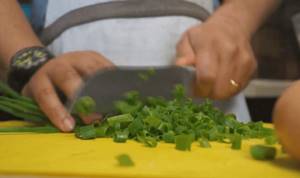
9. Once the broth is cooked (about 60 minutes), you can add the chopped ingredients and dressing. Stir. Turn on the “Soup” mode for 20 minutes.
Once it’s cooked, you can apply it right away. Bon appetit.
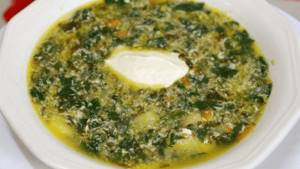
Borscht calorie table
To make it easier to navigate the calorie content of various interpretations of this first dish, use the table:
| Borsch | Calorie content per 100 g (kcal) |
| With porcini mushrooms | 20 |
| Siberian | 48 |
| Cold summer | 49 |
| Ukrainian | 49 |
| With sorrel and bulgur | 35 |
| With pork stew | 35,9 |
| With minced chicken and broccoli | 78,8 |
| With chicken in the oven | 47,5 |
| With beans without meat | 65,1 |
| Pork ribs with boiled beans | 67,2 |
Recipe for green sorrel borscht with chicken and egg
Since green borscht is a dietary dish, it’s worth telling about the recipe with chicken breast. Poultry meat has low calorie content, and therefore the soup will not burden the body.
Let's start with the ingredients. Prepare:
- sorrel – 200 g;
- smoked chicken breast – 350 g;
- garlic - a couple of cloves;
- onion – 150 g;
- carrots – 100 g;
- potatoes – 200 g;
- chicken eggs – 2 pcs.;
- salt, pepper - to your taste;
- vegetable oil - for frying.
Cooking time: approximately 1 hour.
Shall we get started?
1. Peel and cut the onions. Chop the garlic or pass it through a press.
2. Pour some vegetable oil into the frying pan. Add chopped ingredients. Start sautéing for 3 minutes over medium heat.

3. Peel and cut the potatoes into cubes. Place on the onion. Continue frying. 5 minutes over low heat is enough.
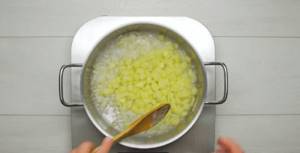
4. At this time, grate the carrots on a coarse grater. Add it to the pan. Sauté for 5 minutes over low heat.
5. Slice the smoked breast. Place it with the vegetables. Mix well. Add salt, pepper and other spices to your taste.
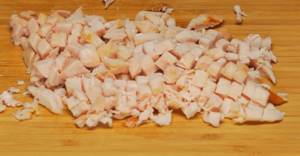
6. After a couple of minutes, pour the mixture with two liters of water or broth. Stir. Bring to a boil, then cook for 5 minutes over low heat.
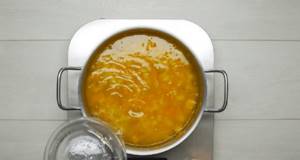
7. At this time, chop the sorrel, first removing excess branches. Add to the pan. Mix well.

8. Now in a bowl, stir 2 raw chicken eggs until smooth. Pour into the pan in a thin stream, stirring constantly.
9. Boil the borscht for a couple more minutes. Then cover with a lid and remove from heat. After a couple of minutes you can put it on plates.
Serve soup with sour cream and fresh herbs. Bon appetit.
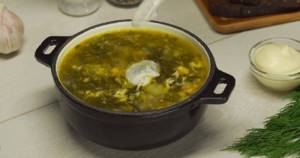
How to cook green borscht with sorrel
Green borscht with sorrel is a traditional dish of Belarusian cuisine, perfect for lunch. We will now tell you in detail how to properly cook this magnificent soup and deliciously prepare green borscht with sorrel.
Step 1.
This recipe is based on chicken broth, although traditionally it is cooked with beef or pork. Chicken will make the dish dietary. To do this, you need to remove the skin from the legs and cut them into two parts. Add 1 whole onion, carrot, and bay leaf, add water and put on fire. When it boils, collect the foam, then cook slowly until the meat is completely cooked.
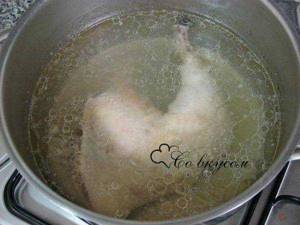
Step 2.
While preparing the broth, you can make the dressing. To do this: grate the remaining carrots, finely chop the onion, add vegetable oil and fry it all in a frying pan until the onion reaches a golden color.
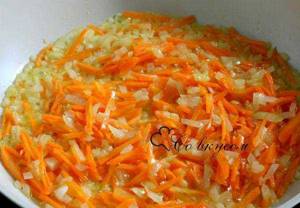
Step 3.
Cut the potatoes into small cubes. Finely chop the pre-boiled hard-boiled eggs and chop the greens.

Step 4.
Remove the cooked carrots, legs and onions from the broth, strain the broth, add potatoes, salt and cook over low heat for 7-8 minutes. Discard cooked onions and carrots.
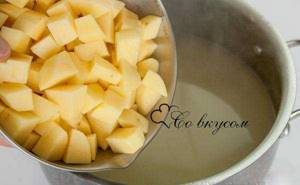
Step 5.
Remove the meat from the bones and cut into small strips. When the potatoes are almost cooked, add meat, eggs and dressing. After boiling, cook over low heat for three minutes.
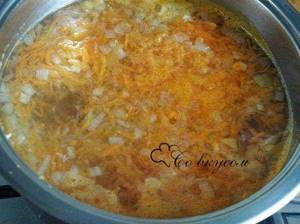
Step 6.
Add chopped herbs, optionally, citric acid, black pepper, mix everything, let it boil and turn off the heat. Let it brew for a while.
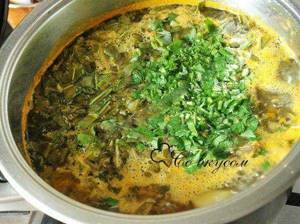
Green borscht with sorrel can be served with sour cream.
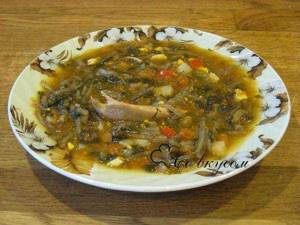
Classic green borscht with sorrel and egg
I will not use meat in this green borscht recipe. The calorie content of the dish will be low, but the dish will be filling and very tasty. The following products should be prepared:
- potatoes – 500 g;
- carrots and onions - 1 piece each;
- sorrel and green onions - a large bunch;
- garlic – 3 cloves;
- tomato juice (paste) – glass (tbsp.);
- eggs – 6 pcs.;
- sugar – 1 tsp;
- salt, pepper, herbs, seasonings - to your taste;
- vegetable oil - for frying.
Cooking time – 60 minutes.
Shall we get started?
1. Place a pan of water for borscht on the fire. You can also use meat broth. At this time, wash, peel and cut the potatoes into arbitrary slices. Cook for 20 minutes after boiling until done
Chef's tip! Before boiling potatoes, you need to rinse them to remove starch under cold running water.
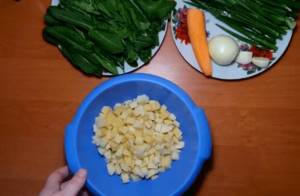
2. At this time, work on other vegetables. Peel and chop the onion. Pass the carrots through a grater. Send everything to the frying pan until soft.
3. At this time, peel and chop or press the garlic
4. Then add tomato juice-paste, sugar, salt, spices, garlic, herbs and bay leaf. Mix well, cover and simmer for a couple of minutes.
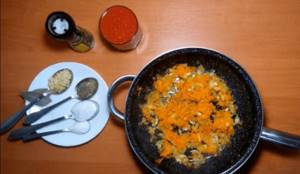
5. While everything is simmering, boil the eggs and take care of the greens.
6. Rinse the sorrel well. Remove the legs. Cut the leaves into strips. Wash and chop the onion. Cut 5 eggs into half rings, and cut 1 into quarters for decoration.
7. Now add all the ingredients to the potatoes in a saucepan. Mix well.
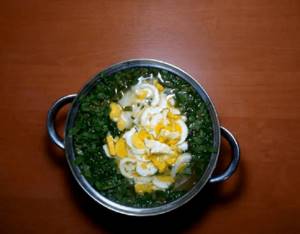
8. After boiling, cook the soup for another 5 minutes. Then you can turn it off. Cover with a lid and let the borscht stand for 10 minutes. Then you can put it on plates.
Don't forget to add a quarter of an egg to each serving. Bon appetit.
